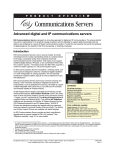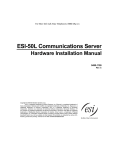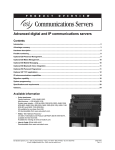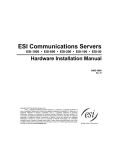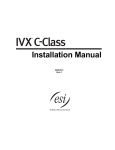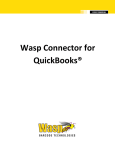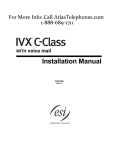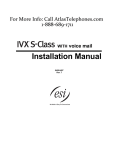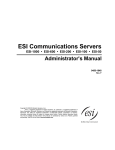Download ADTRAN Aastra 9133i IP Specifications
Transcript
Sophistication in its simplicity ESI Communications Servers represent an innovative approach to digital and IP convergence. The science behind the switch is sophisticated in its simplicity: Design a platform with the flexibility to support digital functionality with the ability to be configured as a purely IP-based communications system. It’s ideal for any business that wants the familiarity of digital telephony, the benefits of full IP-to-the-desktop, or anything in-between. Introduction ESI Communications Servers come in several models, to handle everything from the modest call-handling needs of a small business to the large, customized needs of the enterprise. Each ESI Communications Server is fully flexible. That means it can support traditional digital stations, IP-based, or any combination thereof that 1 the customer requires. The largest model, the ESI-1000, supports a maximum system capacity of 1,128 communications ports. 2 An ESI Communications Server’s backplane , switching matrix, and main board are designed to allow for a traditional digital installation or a VoIP configuration in varying capacities. The non-blocking architecture increases station capacity to a full 3 complement of up to 816 telephones. ESI Communications Servers share many common functions and features. Their innovative architecture integrates advanced IP functionalities, such as dedicated IP resources, the ability to support multiple Integrated VoIP Cards (IVCs), up to 96 Esi-Link channels, and remotely installed IP Feature Phones. All ESI Feature Phone models, both digital and IP-based, provide advanced ESI features. ESI Cordless Handsets come in two sizes, each of which has three models to provide more connection choices — Digital, Local IP, and Remote IP. The 48-Key IP Feature Phone II supports Power over Ethernet (PoE). The optional VIP Softphone combines the functionality of a 48-Key IP Feature Phone II and the 4 VIP Professional product in one PC-based phone. All ESI IP Phones are standards-compliant and operate with the customer’s local area network to promote Quality of Service (QoS). The 48-Key and 24-Key Feature Phones are available with backlit displays. An ESI Communications Server provides an ideal, cost-effective 5 upgrade path for several models of ESI’s IVX systems. See “Migration capability,” page 10, for more details. 1 2 3 4 5 Contents Facts and figures ............................................. 2 Features at a glance ......................................... 3 Advanced IP telecommunications capabilities ............... 8 Migration capability ........................................ 10 Specifications and requirements .................. 10 Glossary ........................................................... 12 Color collaterals available Family brochure: ESI # 0450-1052. System spec sheets: ESI #s 0450-1055 (ESI-1000); 0450-1056 (ESI-600); 0450-1054 (ESI-200); 0450-1053 (ESI-100); 0450-1148 (ESI-50); and 0450-1149 (ESI-50L). All downloadable from www.esicomservers.com/brochures. All ESI documents mentioned herein are available from www.esiresellers.com [(assword required). To support certain ESI Communications Server features — most notably automatic call distribution (ACD) and any IP-related features — the entry-level ESI-50L must be upgraded to an ESI-50. As a result, a number of descriptions in this document do not apply to the ESI-50L. For a complete comparison of ESI systems’ features, consult the Technical and Features Comparison Chart (ESI # 0450-0447), downloadable from www.esiresellers.com/tech (password required). Not applicable to the ESI-100, ESI-50, and ESI-50L. See “Capacity constraints supported,” page 8. See the VIP Product Overview (ESI # 0450-0608). IVX E-Class (IVX 128e and IVX 72e) Generation II and IVX X-Class (IVX 128x and 256x). ESI (Estech Systems, Inc.) • 3701 E. Plano Parkway • Plano, TX 75074 • 800 374-0422 • fax: 972 422-9705 e-mail: [email protected] • Web: www.esicomservers.com 0450-1077 Rev. D ESI Communications Servers Sales Overview Facts and figures Standard features Note: Maximum capacities shown. • • • • • • • • • • • • Capacities System ESI1000 ESI600 ESI200 ESI100 ESI50 System ports 1,128 624 300 108 87 48 Trunk ports 240 168 84 42 35 16 DLCs (for T1/PRI) 10 6 3 1 1 IVCs 34 17 8 3 1 0 816 408 192 84 52 40 3 Station ports 816 408 192 72 12 0 336 168 48 32 32 Analog stations 384 188 56 28 8 8 2 4 2 1 1 1 0 Conference ports 64 64 24 16 16 16 Voice mail ESI1000 ESI600 ESI200 ESI100 ESI50 ESI50L On-bd. integrated auto-attendant/ VM channels 128 32 16 or 24 8 6 6 1,481 1,229 1,121 258 246 User 816 408 192 84 52 40 1,000 16/48 1,000 16/32 190 16/32 190 16/32 41 21 21 21 21 1,200 1,200 140 or 600 140 15 or 60 15 Ext. no. digits ESI1000 3 or 4 ESI600 3 or 4 ESI200 3 or 4 ESI100 3 or 4 ESI50 3 or 4 ESI50L 3 DID translations 1,200 600 300 300 300 n/a 80 40 20 10 10 10 Info./guest 1,000 1,000 Group/Max. mbrs. 64/200 32/64 “Special-purpose” Voice storage 6 (hrs.) Features PRI pilot numbers 7 Line groups Speed-dial nos. (4-digit/3-digit) 4 5 6 7 0 504 Total voice mbxes. 1,941 3 2 Digital stations 5 2 1 IP stations Esi-Link cards (up to 24 Esi-Link 4 chs./card) 1 ESI50L 61 8 8 8 8 Optional applications8 ® • • • • • • ESI Bluetooth Voice Integration ESI Presence Management 9 Mirrored Memory Module (M3) Esi-Link IP private networking Power over Ethernet support for IP Feature Phone II Dual-configuration 48-key IP Feature Phone II (supports local and remote installations) Digital, Local IP, and Remote IP Cordless Handsets 10 Third-party SIP stations VIP (Visually Integrated Phone) family of applications — VIP, VIP Professional, VIP ACD Supervisor, VIP ACD Agent, VIP PC Attendant Console, and VIP Softphone • • • Hardware details ESI1000 Cabinets’ typical mounting Max. cabinets (Base • Exp’n.) Pwr. supplies 8 1,000/ 1,000/ 1,000/ 1,000/ 1,000/ 100 100 100 100 100 Account codes Automatic Call Distribution Built-in Network Services Processor (NSP) Caller ID key Distinctive ring for trunks Enhanced Caller ID Esi-Dex integrated directories Fax tone detection Shared-office tenanting (maximum of eight tenants) Station redial and callback Recording of calls Flexible numbering Processor n/a/ 100 Live-ring list members 48 48 48 32 32 32 Departments 128 64 20 10 10 10 Mbrs. per dept. 64 64 48 32 32 32 Mbrs. per all-ring 48 48 48 32 32 32 Stns. w/ Exp. Cns. 128 80 32 8 4 4 Exp. Cns. per stn. 2 2 2 2 2 2 ESI600 11 1•5 1•3 On-board DSPs • • • The ESI-50 doesn’t support T1. The ESI-50 has a built-in IVC; it accepts no additional IVCs. The built-in IVC supports 12 local IP channels, eight remote IP channels, or a combination thereof whose total can’t exceed 12 IP channels. See “Capacity constraints,” page 8. Esi-Link channels are allocated to “reserved” ports; i.e., Esi-Link channels don’t reduce CO or station capacity. Dynamic assignment allows for unlimited combinations up to the maximum of 16 parties per conference — e.g., 21 three-member conferences, or four four-member conferences in combination with two eight-member conferences. Achieves best audio performance when using digital trunks. The differing quantities for the ESI-200 and ESI-50 reflect those models’ Memory Module choices. With 10 or fewer Esi-Link locations (Esi-Link n/a for the ESI-50). • • 8 9 10 11 12 2 ESI100 ESI50 1•1 1•1 One per cabinet One MCF-5407 MCF-5272 54 128 66 64 3 ESI50L Wall 19-in. rack Speed (MHz) SDRAM (MB) ESI200 32 2 Cabinet connection: front-connected cable, included with each Expansion Cabinet 12 Optional power shelf : separately fused connection for four power supplies, plus two additional AC outlets for powering of ancillary equipment or technician’s laptop PC Grounding: One grounding lug and terminal per cabinet; common-point grounding recommended ® ® Processor: Motorola ColdFire commercial-grade microprocessor (specific model, speed, and SDRAM shown in table above) On-board digital signal processors (DSPs) manage hard disk drive controller, inter-card communications, and telephony services IP-related items not supported by the ESI-50L. Standard on ESI-1000; not available on ESI-100, ESI-50, or ESI-50L. See “Advanced IP telecommunications capabilities,” page 8. Each cabinet supports seven “hot-swap” universal card slots. Intended primarily for ESI-1000, ESI-600, and ESI-200. ESI Communications Servers Sales Overview Features at a glance Integrated voice mail 1 A full complement of practical, easy-to-use voice mail features is standard on every ESI Communications Server : • • • • • • • • • • • Up to 128 built-in voice mail channels Recording at highest grade of voice quality (64-Kbit/second sampling) Up to 1,200 hours of voice message storage Support for 12 message-on-hold recordings (three pre-recorded tracks plus nine customizable recordings) Notification of new messages to a phone or pager ™ ESI’s unique Quick Groups feature to leave messages for several mailboxes at once ™ ESI’s Quick Move function to record conversations directly into another user’s mailbox Different mailbox types for customer applications (broadcast, information, cascade, Q & A, and guest mailboxes) 2 Individual “reach-me” number per mailbox, with Intelligent Call Forwarding Message Recycle Bin that can restore the 10 most recently deleted messages ™ Virtual Mailbox Key to allow easy management and monitoring of a second mailbox Unlike most systems, an ESI Communications Server is equipped for up to 128 channels of voice mail, standard. There is no need to balance voice mail needs at the expense of a customer’s call-handling requirements. There are no expensive port expansion cards required, saving the customer thousands of dollars in add-on costs over the life of the system. Plus, there is no charge for features that other manufacturers may make available only at an additional cost, such as customizable music-on-hold recording tracks and department announcement recording. By providing a full complement of voice mail features as a standard offering, your competition may be required to include ancillary equipment at an extra cost to meet your proposal. Auto attendant Each ESI Communications Server provides rich, comprehensive auto attendant features, such as: • • • 100 branches (six levels deep) for a caller-friendly answering environment Virtually unlimited call routing, including off-premises transfer Three-character dial-by-name Multiple menus can help you design an elegant “main” company greeting. Be careful to keep all prompts short, and ensure all instructions are clear for all callers. Flexible conference channels 1 The ESI Communications Server has channels reserved exclusively for conferencing. • • • Dynamically connected in multi-party conversations up to 16 channels per conference Any combination of conference channels may be joined together Conference channels are dynamically balanced for optimum audio performance Since the reserved conference channels can be used in any combination, the customer always has the flexibility to add parties, even during a conference call. There is no need to sign up for an expensive conferencing service or purchase a separate third-party conference bridge device. By balancing the 3 conference channels, optimum audio performance is achieved for all parties. Shared-office tenanting4 Multiple businesses can share a common telephone system. • • • • • Private or dedicated outside lines by line groups Distinctive incoming ring assignments per tenant Separate auto attendant greetings and branches Individual “dial 0” operators, music-on-hold sources, and paging zones Unique day/night modes of operation Professional offices on the same floor of an office building will find shared tenanting an attractive alternative to purchasing their own system. Examples include doctor offices or law firms. Because all 1 2 3 4 For specific capacities, refer to “Facts and figures,” page 2. Installation of PRI digital circuit required for Intelligent Call Forwarding feature. Digital trunks are recommended when joining the maximum of 16 parties in a single conference. Not supported by the ESI-50L. 3 ESI Communications Servers Sales Overview tenants maintain a true separation of system resources and facilities, potential conflicts for outside lines, long distance charges, and choices of music- (or message-) on-hold are eliminated. This is particularly desired by automobile dealerships that represent two or more lines of vehicles; each type of dealership wants to ensure that advertisements for a competitive line are not inadvertently played to their customers on hold. ESI Bluetooth® Voice Integration Simplify and enhance communications by integrating Bluetooth-enabled cell phones and headsets with an ESI Communications Server. ESI Cellular Management ESI Bluetooth Headset Interface • • • • • Interface for Bluetooth-capable cellular phones Easily make or take cell phone calls on an ESI 48-Key Digital Feature Phone or IP Feature Phone II Unanswered cell phone calls can route to an ESI mailbox or cellular voice mail Share cell phone access as if it were an extra CO line, but without the expense. • Lets you “pair” an ESI 48-Key Digital Feature Phone or IP Feature Phone II with a standard Bluetooth headset Allows seamless answering, origination, and termination of calls using the Bluetooth headset A key differentiator, ESI Bluetooth Voice Integration facilitates the use of Bluetooth-enabled cell phones and headsets with ESI Communications Servers. Busy professionals will enjoy the convenience of taking cell phone calls on their ESI 48-Key Digital Feature Phone or IP Digital Feature Phone II, using ESI Cellular Management; incoming calls to the cell phone are handled by the ESI Communications Server just as a CO trunk call would be. And the ESI Bluetooth Headset Interface permits Bluetooth headset users to seamlessly answer, originate, and terminate ESI desktop phone calls directly from the headset. Note: For more complete details about this product, consult the ESI Bluetooth Voice Integration Product Overview (ESI document # 0450-1173). Resellers may download this document from www.esiresellers.com (password required). ESI Presence Management 1 ESI offers an innovative combination of RFID technology and business telephone applications • • • • • • Remote entry control with built-in doorphone Access control through the use of authorized electronic keys (key fobs or scan cards) Presence indication to show “in” and “out” status of employees on programmed DSS keys Personal call routing to modify the behavior of a station when the user is scanned in or out Access door report for tracking access to designated areas 2 Optional third-party WaspTime software application to track, sort, and prepare employees’ attendance data for easy entry into common business payroll software applications Offer ESI Presence Management as a remedy for any business that needs to control access to areas of its office. You will frequently eliminate competition and increase your chance to close the sale. When you add the optional third-party software to your proposal, your competition will likely be forced to bring in a third-party VAR (value-added reseller) who has expertise in the time-and-attendance field, adding additional design, equipment, and implementation costs to their bid. Note: For more complete details about this product, consult the ESI Presence Management Product Overview (ESI document # 0450-0794). Resellers may download this document from www.esiresellers.com (password required). Enhanced automatic call distribution3 Manage call overload and increase customer satisfaction. • • • • Prioritize and route calls within designated departments for quickest possible call handling Agents receive up-to-the-second information on call queues and wait times A separate hold recall timer is provided for ACD agents, further ensuring that customer care is enhanced Agents can log into two separate ACD departments simultaneously On ESI Communications Servers (except for the ESI-50L), automatic call distribution is a standard feature. Other systems of this size require an optional (and often costly) software package to be added 1 2 3 Radio frequency (RF) identification. Not sold by ESI. Available by direct purchase from the manufacturer, Wasp Barcode Technologies (www.waspbarcode.com). Not supported by the ESI-50L. 4 ESI Communications Servers Sales Overview to provide call routing, real-time agent activity viewing, and on-screen displays of calls in queue and wait times. Callers remain informed during their wait time by standard announcements that are included as part of ESI’s voice mail system. By including ACD as a standard feature, you save the customer thousands of dollars. Be sure to make ACD a part of your ESI recommendation on every presentation. Verbal User Guide™ 1 Instant access to assistance in operating the ESI phone and mailbox. • • • • More than 200 instructional prompts are provided A tutorial script explains every feature of the system Tutorial sessions can be suspended, and resumed at a later time Help can be requested while on a call By pressing the HELP key, the user can listen to extensive spoken and displayed prompts to assist with phone operation, voice mail features, programming instructions, and more. The Verbal User Guide is available for use whether the user is idle or on a call. System administrators and Reseller technicians can also use the Verbal User Guide to prompt them through infrequently-used programming changes. By having this feature available to every extension user, your customer can save the cost of retraining his employees. As a productivity tool, new employees come up to speed rapidly when literally, they have the key to every feature instruction. Esi-Dex™ Hundreds of frequently dialed phone numbers can be easily stored in Esi-Dex. • • • • Station Dex provides a current listing of all extension numbers Personal Dex includes all speed-dial entries programmed by each individual user System Dex is a complete list of system-wide stored speed-dial entries Location Dex (available when Esi-Link is installed) lists all dial access codes associated with each location within an Esi-Link private network. Instead of devoting several keys on the phone to access different types of speed-dialing directories, the 48-Key Feature Phone has an ESI-DEX key just below the display. Locate and dial anyone in a Dex using just the ESI-DEX key and the scroll keys. The instructions for using Esi-Dex are so similar to how a mobile phone user locates and dials someone in his cell phone that it is virtually intuitive to the ESI station user. Saving numbers to the personal Dex is just as easy. The Caller ID of an incoming call or a voice mail message is saved to the Personal Dex with one touch of the ESI-DEX key. By making it so easy to use, ESI assures that the user will actually get to enjoy Esi-Dex’s timesaving benefits. Additionally, this is an excellent example of the tight integration of an ESI Communications Server and the voice mail, which should be highlighted to the prospect. Intelligent Call Forwarding™2 Users can forward their calls off-premises yet view the original Caller ID information. • • • Handle customer calls with confidence wherever you are, day or night Better time management by answering only those calls you want PRI digital trunk circuits are required for the operation of this feature Most systems that permit off-premises forwarding will only send the Caller ID of the office CO line used to patch the incoming caller with the station user. In this case, the user can’t distinguish whether the call is actually from someone in the system or a forwarded outside caller. An ESI Communications Server manipulates the call set-up information of the digital PRI channel to embed the original Caller ID in place of that of the ESI Communications Server’s outgoing line indication. This allows off-premises users to answer forwarded calls with confidence, knowing who is on the other end of the call. The Intelligent Call Forwarding function, coupled with the “reach-me” feature of each mailbox, keeps the user in touch with the office and his customers at all times. Note: For more complete details, consult the Intelligent Call Forwarding Feature Overview (ESI document #0450-0674). Resellers may download this document from www.esiresellers.com (password required). 1 2 Not available on the 12-Key Feature Phone or ESI Cordless Handset. Not supported by the ESI-50L. 5 ESI Communications Servers Sales Overview Personal Caller ID1 Assign unique Caller ID information for each station in the system, in place of the company’s leading number identification data. • • • Users’ Caller ID information can reflect assigned Direct Inward Dial (DID) numbers 2 Satisfies most municipal requirements for compliance with E-911 regulations Permits “blind” Caller ID to be sent on outgoing calls At times, it’s inappropriate for the Caller ID of the company’s main telephone number to be displayed on a called party’s phone. For instance, if the customer is a credit consolidation firm or a collections agency, it would not be beneficial to advertise who is calling before someone answers the phone. In the case of human resources departments, it might jeopardize a potential new hire’s position with his current employer if a competitor’s phone number appeared on his telephone. Likewise, attorneys and doctors’ offices may not want their calling activities to be publicized. When a company changes its block of DID numbers or is using DID for the first time, there is always a challenge to get callers to learn and use the new “private lines.” Modifying the Caller ID and sending it out on all outgoing calls is a good way to disseminate these new numbers. From a safety perspective, it is important to let emergency response personnel know exactly who is calling for help. In large buildings or multi-floor facilities, precious time is lost by forcing emergency personnel to search for the at-risk “911” caller. Flexible numbering Flexible numbering provides the means to assign extensions, mailboxes, and department numbers based on specific customer requirements. An ESI Communications Server’s flexible numbering is separated into three parts: 1. Selecting a numbering plan template; 2. Reassigning ranges of extensions, mailboxes, departments, and speed-dial numbers (if needed); 3. Reassigning numbers for individual extensions, mailboxes, departments, and speed-dial numbers. Customers benefit by: • The ability to use their existing extension numbers when installing an ESI Communications Server. This reduces the learning curve of a new system by maintaining the familiarity of the company directory. In some cases, the cost of printing new business cards, letterhead, and other business collateral may be eliminated. • Match a series of DID assignments with extension numbers. It’s not uncommon for a customer to have limited control over the numerical series of DIDs assigned by the telephone company. An ESI Communications Server’s numbering flexibility increases the convenience for both your customers and their callers. • Extension numbers can be easily exchanged between phones. This is very helpful to businesses where personnel change office locations frequently. An exchange of extension numbers lets each station retain his own mailbox and greetings, Personal Dex entries, and programmable feature key programming. Note: Additionally, those using Esi-Link (see page 9) benefit from network numbering, which allows a single numbering plan to work across multiple Esi-Link locations, simplifying the dialing of remote locations. (In an Esi-Link network, certain ESI Communications Server selectable numbering templates can be incompatible with some ESI systems.) For additional details about this information, see the Esi-Link Product Overview (0450-0214). 1 2 Requires the installation of a PRI digital trunk circuit. Check local regulations regarding E-911 compliance. 6 ESI Communications Servers Sales Overview Optional PC applications VIP and VIP Professional 1 ESI’s optional VIP takes the power of Microsoft® Outlook® and adds telephone, fax , and voice mail control. The familiar Windows graphical user interface is intuitive and easy to learn, requiring minimal training. VIP is offered in two user configurations: the basic VIP and VIP Professional. Each configuration is licensed independently. A license is available for purchase to enable VIP users to upgrade to VIP Professional easily at any time. VIP users can: • • • • • • Manage voice mail, e-mail, and faxes from the Outlook Inbox Organize all contacts in one convenient list Control the ESI 48-Key Feature Phone from a desktop PC Capture all inbound and outgoing calls in historical log files Program the phone with just a few mouse clicks Manage settings for optional ESI Bluetooth Voice Integration and ESI Presence Management The VIP Professional user benefits from additional features and functional enhancements, such as: • • • Enhanced graphical user interfaces (GUI) to further increase user efficiency Text-messaging to provide a quick method of communication between VIP Professional users Auto-record feature to ensure that select VIP Professional users (up to 16) never again miss recording an important call Unlike many unified messaging offerings, VIP does not require the installation of a Microsoft Exchange® server. This puts a powerful call and message management tool within financial reach for even smaller businesses. Note: For more complete details, consult the VIP Sales Overview (ESI document #0450-0920). Resellers may download this document from www.esiresellers.com (password required). There are three other members of the VIP family of PC applications: VIP PC Attendant Console, VIP ACD, and VIP Softphone. VIP PC Attendant Console VIP PC Attendant Console provides expanded fields that include views of incoming calls and held calls. A Virtual Button Window is also included to provide single-button access to as many as 400 stations, departments, mailboxes, and speed-dial numbers, in any combination. Note: For more complete details, consult the VIP PC Attendant Console Sales Overview (ESI document #0450-0916). Resellers may download this document from www.esiresellers.com (password required). VIP ACD2 VIP ACD Supervisor and VIP ACD Agent make it even easier to use an ESI Communications Server’s built-in ACD. Each version is compatible with VIP Professional and also includes features for viewing agent status. VIP ACD Supervisor further gives the ACD manager a real-time status display of departmental performance and access to department reports. Note: For more complete details, consult the VIP ACD Sales Overview (ESI document #0450-0989). Resellers may download this document from www.esiresellers.com (password required). VIP Softphone2 VIP Softphone gives a “road warrior” most capabilities of an IP Feature Phone II, right on the PC screen. It also provides VIP Professional-level features and a choice, at purchase, of local or remote operation. Note: For more complete details, consult the VIP Sales Overview (ESI document #0450-0920). Resellers may download this document from www.esiresellers.com (password required). 1 2 Requires the installation of a third-party fax server software application. Also requires PRI line, which is not supported by the ESI-50L. Not supported by the ESI-50L. 7 ESI Communications Servers Sales Overview Advanced IP telecommunications capabilities1 A key advantage of ESI Communications Servers is the robust infrastructure that governs both locally LAN-based IP telephony and remote IP applications. Each ESI Communications Server complies with major industry standards. This ensures the best audio quality experience for ESI Communications Server IP users, regardless of their location. • • • • • • • • User Datagram Protocol (UDP) Layer 3 QoS support via Differentiated Services (Diffserv) Packet compression levels of G.711 (for locally installed IP stations), G.726 (for remotely installed IP stations), and G.729 (for 2 Esi-Link connectivity) 802.3 100Base-TX Ethernet interfaces Layer 2 Quality of Service (QoS) support through compliance with 802.1p for voice packet prioritization and 802.1q for VLAN (Layer 2) support 802.3af Power over Ethernet Dynamic Host Configuration Protocol (DHCP) for IP address conservation within a customer’s LAN Session Initiated Protocol (SIP) to support third-party SIP-compliant IP telephones Benefits of QoS Networks that are designed to support QoS are best suited for IP deployment since quality of voice is judged by the endto-end experience of the user. It is not sufficient for ESI’s IP applications to support QoS if all network components used in the transport of voice over the customer’s LAN are not properly configured for QoS support. The benefits of end-to-end QoS in an IP telephony application are many, and when absent, quite noticeable to the user: • • • • Available bandwidth is optimized by ensuring that voice packets are sent and delivered at a higher priority than “regular” data traffic on the LAN. This may allow the customer to delay upgrading the speed of transmission of his network. He may be able to defer this expense until other applications are added or IT changes in the business dictate its necessity. The quality of the IP conversation is improved by ensuring that voice packets are delivered and “reassembled” at the other end of the conversation in order. This eliminates garbled conversation, hollowness, and noticeable gaps in speech. Unlike data packets, voice packets cannot be resent if they are dropped. Jitter is reduced for voice packets by QoS. This improves the likelihood that all voice packets will not be dropped before being delivered at the other end of the IP conversation, as happens when the amount of jitter of a packet exceeds an acceptable level. The latency with which voice packets are delivered is minimized in a network employing QoS. This results in more natural-sounding speech patterns for both sides of an IP conversation. Note: Many Internet service providers (ISPs) support QoS only if a service level agreement (SLA) has been obtained. Capacity constraints When installed in an ESI Communications Server, an IVC (Intelligent VoIP Card) can be populated with up to 24 48-Key 3 IP Feature Phone II instruments. An ESI Communications Server’s full station capacity can be reached either (a.) with all extensions installed as IP stations or (b.) when a minimum number of the installed stations are IP instruments (as shown in the following table). Config. for full capacity Card slots used IVCs Other cards IP stations Other stations ESI-1000 42 of 42 29 13 696 120 ESI-600 26 of 28 14 12 336 72 ESI-200 13 of 14 6 7 144 48 ESI-100 4 of 4 3 1 72 12 ESI-50 1 (built-in) 1 (built-in) n/a 12 n/a Note, however, that (except on the ESI-50) the entire system can be configured with only IP stations, by installing only IVCs. (The quantity of IVCs each system will support varies by system model; see “Facts and figures,” page 2.) 1 2 3 Not supported by the ESI-50L. The ESI-50 uses only the G.726 speech compression algorithm and, therefore, can be in an Esi-Link network with only other ESI Communications ® Servers set to G.726. ESI’s IVX X-Class and IVX E-Class systems, as well as the original ESI-600 (prior to system software version 16.2.0), use only the G.729 speech compression algorithm; thus, an ESI-50 cannot be in an Esi-Link network with these systems. Except for the ESI-50. Its main board has a built-in IVC 12 which supports up to 12 IP channels (of which eight can be remote). 8 ESI Communications Servers Sales Overview Esi-Link private IP networking capabilities 1 The IVCEL24 card is reserved for the support of 24 Esi-Link channels. With the Esi-Link IP networking option, up to 100 individual sites may be connected together via a customer’s WAN or the Internet. The following table shows how many Esi-Link IVCs may be installed in each ESI Communications Server, and the resulting number of possible, simultaneous VoIP connections between systems: Maximums Esi-Link IVCs Inter-system VoIP connections ESI-1000 4 96 ESI-600 2 48 ESI-200 1 24 ESI-100 1 24 ESI-50 1 (built-in) 2 12 Note: For more complete details, consult the Esi-Link Product Overview (ESI document #0450-0214). Resellers may download this document from www.esiresellers.com (password required). IP station sets Several types of IP telephones are supported by ESI Communications Servers: • • • • • The 48-Key IP Feature Phone II can be installed in-house on the customer’s LAN, or remotely wherever a broadband connection is available. Each 48-Key IP Feature Phone II contains a two-port Ethernet switch. This means that a single Ethernet connection to the LAN is all that is required for the connection of both the customer’s IP Phone and his office computer. This reduces the customer’s data cabling cost by half. The ESI Communications Server’s support of Quality of Service is critical when using the integrated twoport Ethernet switch. This ensures that there is no loss of audio or dropped voice packets during large data downloads. The phone includes built-in Power over Ethernet (PoE) capabilities. In those cases where the customer does not have PoE switches installed, the optional 48VDC adapter is used to provide operating power to the phone. The 48-Key IP Feature Phone II may also be installed outside the confines of the customer’s LAN. When installed remotely, the phone uses the higher compression rate of G.726 to maximize voice quality. A remote location might include a remote facility, home office, or any other location where broadband access is available. Remote IP users are connected directly to the system via the IVC card, and therefore operate as if they were on-premises. The 48-Key IP Feature Phone II is available with backlit display. The ESI Local IP Cordless Handset provides connection of the customer’s LAN to the phone’s base station. Users of the Local IP Cordless Handset are free to move throughout their facility while staying in touch with customers and co-workers. This IP phone also supports PoE, requiring no additional AC power outlet for the transceiver base station. For remote teleworkers, ESI also offers the Remote IP Cordless Handset. This phone connects like a “wired” Remote IP Phone, and can be installed anywhere broadband access is available. This, also, is a PoE phone. An inexpensive PoE Adapter connects between the remote router and the cordless IP phone. The base station of the remote IP phone has a built-in RJ-11 jack into which the teleworker’s home phone line can be connected. This is a convenience for the remote worker so that only one phone can be used to answer and call on either line. The optional VIP Softphone combines the functionality of a 48-Key IP Feature Phone II and the VIP Professional product in one PC-based phone. For more information about this product, see also “Optional PC applications,” beginning on page 7, as well as the VIP Sales Overview (ESI # 0450-0920). ESI additionally supports local-only SIP-compliant hardware endpoints — i.e., SIP “phones.” However, due to limitations with SIP itself, not all of the ESI feature set is available via a SIP phone. The following SIP hardware endpoints have been tested with one or more ESI Communications Server models: — Aastra 9133i — Grandstream BudgeTone 101 — Grandstream HandyTone 286 Note: Each compatible ESI IP Phone [IP Feature Phone II, IP Cordless Handset (Local or Remote), or VIP Softphone] or SIP endpoint requires an available IVC port and the activation in the system of a local, remote, or SIP license before the IVC will connect to the IP Phone. When an IP Phone is programmed in the system, a license is consumed. There are many benefits to designing an IP telephony application with Power over Ethernet capabilities: • • • 1 2 By using the local area network to power the IP phones, a consistent voltage is provided to all phones without the fluctuations that frequently occur in commercial office buildings. Since all power is provided from one location, a single UPS system can be used to protect the IP phones from power surges, brownouts, and other electrical anomalies. Powering the IP phones via the customer’s LAN saves the cost and inconvenience of providing a fused power strip at each IP phone placement. Not supported by the ESI-50. Its only IP support comes from its built-in IVC 12, which supports up to 12 IP channels (of which eight can be remote). The ESI-50 uses only the G.726 speech compression algorithm and, therefore, can be in an Esi-Link network with only other ESI Communications ® Servers set to G.726. ESI’s IVX X-Class and IVX E-Class systems, as well as the original ESI-600 (prior to system software version 16.2.0), use only the G.729 speech compression algorithm; thus, an ESI-50 cannot be in an Esi-Link network with these systems. 9 ESI Communications Servers Sales Overview Power over Ethernet component compatibility ESI has tested several Power over Ethernet devices for compatibility with its PoE IP phones. The following devices have been tested with one or more models of ESI Communications Servers: • • • Cisco Catalyst 3560 24-port 10/100T PoE Adtran Netvanta 1224 PoE 3Com Superstack 3 4400 switch power In addition, the following mid-span Power over Ethernet devices have been tested: • • 3Com 3CNJPSE24 24-port Midspan Solution D-link DWL-P1012 12-port PoE Midspan Dedicated voice over IP resources A codec takes the analog spoken voice and encodes it as an IP packet, so it can be compressed and transmitted as a “data” packet. When received by another IP device (IP Phone or other Esi-Link system), the IP packet is decoded to re-convert it into analog voice. IP communication is impossible without codecs. With dedicated codecs on each available IVC and IVC 24EL channel, an IP Phone or Esi-Link user will never be denied the ability to place or receive a call due to a lack of a codec. Migration capability 1 For customers who outgrow their existing ESI systems, an ESI Communications Server provides the perfect upgrade path. Most station equipment currently installed on an IVX E-Class or X-Class system may be reinstalled on an ESI Communications Server. Generally, all Generation II port cards are fully supported by ESI Communications Servers. Migrating from an ESI-50L to a 60-hour ESI-50 requires a different CompactFlash Memory Module, because the ESI-50L’s Memory Module is a 15-hour model. Specifications and requirements System components The Base Cabinet includes the main board, which controls all call control and switching within an ESI Communications Server. The main board also contains these integrated connectors and components: • • • • • 1 2 3 4 5 Memory Module — Depending on system and configuration, this is either a CompactFlash® device or a hard disk drive. It contains all system programming and configuration data, and pre-loaded voice prompts. The Memory Module provides voice storage at 64 kilobits/second — the industry's highest-quality sampling rate. Network Services Processor (NSP) —The NSP provides connection between the ESI Communications Server and the customer’s 2 LAN. The NSP provides remote access via Ethernet and the Internet for system programming and maintenance. The NSP is required for all LAN-based options, such as VIP. 3 4 M3 memory back-up — Using RAID -1 hard disk drive technology, the Mirrored Memory Module (M3) maintains system operation on a separate disk drive in the event of a hard disk drive failure. This mirrored hard drive controller provides redundancy of system programming, speed-dial entries, and voice mail messages and prompts. On-board MOH and overhead paging inputs — Connection of ancillary equipment is easy using the built-in jacks on the front plate of the Main Board. Serial port —SMDR call detail data is output from this port. Technicians connect their laptop computers to this port to perform onsite programming. The selectable extended SMDR format shows answered and unanswered calls coming into the auto attendant, 5 extensions, and ACD . No migration path is available for customers of the legacy IVX 128 and IP E-Class systems. Local area network. Standard on the ESI-1000; optional on the ESI-600 and ESI-200; not available on the ESI-100, ESI-50, or ESI-50L. Redundant Array of Independent Drives. ACD not supported by the ESI-50L. 10 ESI Communications Servers Sales Overview Power consumption The following table shows the power consumption of each ESI Communications Server when fully loaded: System ESI-1000 ESI-600 ESI-200 ESI-100 ESI-50, ESI-50L Cabinets (Base and Expansion) 6 4 2 2 2 Power consumption (watts) 1,080 720 360 125 72 ESI-1000, ESI-600, and ESI-200 For the ESI-1000, ESI-600, or ESI-200, each Base Cabinet or Expansion Cabinet is powered by its own separately fused power transformer. For rack-mounted systems, a power shelf is available onto which all power transformers may be mounted so only one power cable is required for connection to a commercial AC power outlet or UPS system. Since each cabinet has its own distributed power, the heat dissipation of each power “brick” is well within the environmental range for proper operation of all system components. In an installation environment with insufficient space surrounding the system and mounting rack, the power shelf may be mounted at the top of the rack (above the Base Cabinet) so that the power bricks can utilize convection cooling as a means of dissipating any potential build-up of heat. ESI-100, ESI-50, and ESI-50L For the ESI-100, ESI-50, and ESI-50L, each Base Cabinet shares a 24-VAC power supply “brick” (five-amp on the ESI-100, and three-amp on the ESI-50 and ESI-50L) with an Expansion Cabinet which is installed upon the Base Cabinet. Typically, the connected cabinets will be wall-mounted, which should allow sufficient space to allow venting of heat from the power supply. Special software requirements Flexible numbering and compatibility with the optional VIP Softphone and VIP ACD (Supervisor/Agent) applications are available with the following system software: 1 • ESI-1000, ESI-200, ESI-100, ESI-50, and ESI-50L — All versions. • ESI-600 — Version 16.1.0 (and higher). Environmental considerations Common sense should dictate where an ESI Communications Server is installed: a dry, clean and accessible area. Every ESI Communications Server is tolerant of broad ranges in environmental characteristics: • • The ambient room temperature should fall within the range of 40°–80° F. The relative humidity in the room should not exceed 90%. If the equipment is to be rack-mounted, ensure that there is adequate room for a standard 19-inch rack. If wall mounting is planned, ensure that all power cords have ready availability to a 110 VAC power outlet. For optimum performance, ensure that the system is located no further than 1,000 feet from the farthest station location. FCC regulatory information Each ESI Communications Server model has been tested and found to comply with the limits for a Class A digital device, pursuant to Part 15 and Part 68 of the FCC Rules. These limits are designed to provide reasonable protection against harmful interference when the system is operated in a commercial environment. The FCC number for all ESI Communications Servers is 1T1MF08B33727, with a ringer equivalency of 0.8. ESI Communications Servers and all associated ESI telephone station equipment meet all FCC requirements for hearing-aid compatibility. 1 The ESI-50L is incompatible with both VIP Softphone and VIP ACD. It may be upgraded to an ESI-50, which supports both applications. 11 ESI Communications Servers Sales Overview Glossary Codec — The device required to encode analog spoken voice into IP packets for transmission through a VoIP network. The encoded voice is decoded at the receiving end, converting voice into an analog component. HDD — Hard Disk Drive; the device on which the system’s operating software program, and voice mail prompts and messages are stored. IEEE — Institute of Electrical Engineers; the professional organization that establishes standards for, among others, the telecommunications industry. ICC — Inter-card communication; describes the method by which cards within a cabinet, as well as multiple card cabinets, communicate with each other. NSP — Network Services Processor; the ESI device, mounted on the Main Board, that provides for an Ethernet connection between the ESI Communications Server and the customer’s local area network (LAN). Multiple applications may run concurrently over the NSP connection, such as VIP and remote Internet programming. PoE — Power over Ethernet; this IEEE standard (802.3af) defines the method of injecting power over a customer’s local area network cabling infrastructure to operate TCP/IP devices at the Ethernet port. ESI uses this method, in conjunction with a customer-provided power switch, to operate its PoE local IP Phones. RF — Radio frequency. RFID — Radio frequency identification. RAID1 — Redundant array of independent drives. VoIP — Voice over Internet Protocol. About ESI ESI (Estech Systems, Inc.) is a privately held corporation based in Plano, Texas. Founded in 1987, ESI specializes in business communications systems. ESI pioneered the all-in-one telephone and voice mail system. The original IVX, introduced in 1996, represented a radical breakthrough in system design: the inclusion of a full suite of features within a single integrated system. Since its days as a small start-up, ESI has enjoyed exceptional stability and growth while maintaining its dedication to small-company values — including the need to take care of the most important part of the equation: your business. Copyright © 2009 ESI (Estech Systems, Inc.). IVX is a registered trademark of ESI. Other registered trade names mentioned herein are trademarks of their respective owners. ESI phone systems are protected by various U.S. Patents, granted and pending. Product appearance, and other details and features described herein, are subject to change without notice. Some features may not be available at initial release. More information on ESI and its products is available on the World Wide Web at www.esicomservers.com. 12












